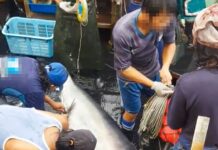By Mary Mwendwa
Samburu County, Kenya: It has been said the current and fourth President of the Kenyan Republic Hon. Uhuru Kenyatta was conceived in a house in Samburu County.
Recently when l toured Samburu County, l decided to visit the house and see for me.
On arrival, the curator John Rigano reveals there were charges that we had to pay and settle before taking a tour of the house. Kenyans pay Sh 100 and their children KSh 50. Residents of East Africa pay KSh 400 and their children and their children KSh 200s, while foreigners pay KSh 500 and their children KSh 250.
And, there it was, Kenyatta House which is said to hold great significance to Kenya’s independence and its leadership.
It is a three-bedroomed bungalow, painted in white and located on the sides of a hill near Maralala town. The house sitting on a 28-acre piece of land and built in 1959, is now a historical site under the National Museums of Kenya.
“Was President Uhuru Kenyatta conceived here,” l inquired after l paid. Instead of answering, Rigano opens a drawer and fishes out a visitor’s book, flips through several pages, before settling on one of the pages, and tells me to read.
The writings in black pen read: “Conceived in this house in the year 1961. A pleasure to be back using my own two feet.” It was Uhuru’s own confirmation that indeed, he was conceived there when he visited the house on July 1, 2007.
In the sitting room, there’s a wooden couch with canvas pillows and a dining table. He warns us not to sit on the chairs for they need to be preserved for future generations.
There’s a host of Jomo Kenyatta photos on the walls. Some of the photos include a huge framed black and white photo of Jomo Kenyatta, and a group photo of Kenyatta and friends among them Wanyiri Kimomori, a cobbler, and Johnson Njoroge.
The curator reveals the first President Jomo Kenyatta spent his last days of restriction in 1961, before independence in the house. The house was initially for the senior colonial administrators who worked in Samburu area.
Kenyatta was second to live in it between April 1961 and August 1961 after being transferred from Lodwar where he was detained by the colonial government for his alleged involvement with the Mau Mau movement in 1953.
Rigano dispels the notion that Kenyatta was detained in Maralal House. He explains: “Kenyan independence was born in this house. When the colonial government realized it was inevitable for Kenya to gain its independence, they picked on Jomo Kenyatta, amongst the four heavyweights Ronald Ngala, Tom Mboya, Oginga Odinga.”
He explains a white settler, the late Sir Michael Blundell, who was acting as a liaison between the colonial government and Kenyatta recommended Kenyatta against the others. Blundell facilitated Kenyatta’s move from Lodwar to Maralal.
He says in Maralal, Kenyatta was allowed the freedom to walk to a nearby shop in the company of his two bodyguards. However, Kenyatta was only allowed to talk to no more than 10 people at once.
While in Maralal, his family; Mama Ngina and her two children, Christine Wambui, now (Christine Pratt), and Jane Njeri came to live with him.
After getting most of the story in the sitting room, we move to the guest room that has a bed where his visitors spent their nights.
The curator let us into the master bedroom. Here, there’s a study desk facing the window. Looking through the window one sees a hilly landscape, far away. He reveals anyone can see the apex of Mt Kenya during morning and evening hours.
“Kenyatta sat here while working on his book, Facing Mount Kenya,” he reveals. The bedroom has a dressing table with a full-length mirror.
It also has a metallic bed with springs and a mattress made of sisal fibers, and chest drawers. Also present is a charcoal iron box that Kenyatta used to press his clothes before meeting visitors.
“This is the first project of Uhuru. The second is when Moi declared him as the best person to lead the country, in 1999,” said the curator, amidst laughs.
We also toured the children’s bedroom which has two beds and a reading table.
In the kitchen, there’s a small kitchen with a firewood oven that could bake bread, cook, and at the same time heat water bathroom water. There are washrooms and bathtubs.
Isn’t repainting tamper with its original history? Rigano assures: “Everything in the house has been maintained to look like it was in 1961. True, the walls have been repainted but retain the original colors.”
Now 57 years old, the house which is privy to the greatest secret agreement of land signed between Kenyatta and colonialists still is very strong.
















